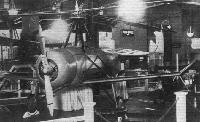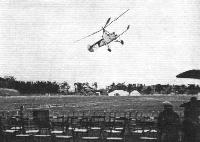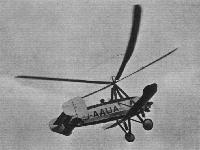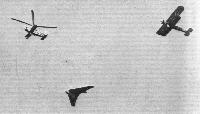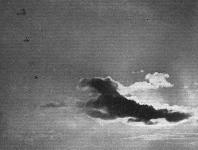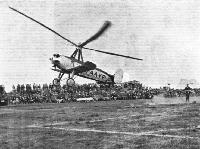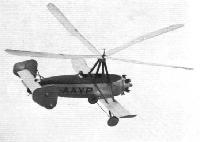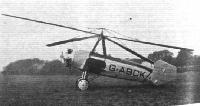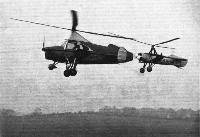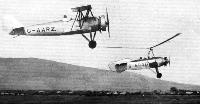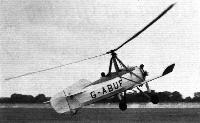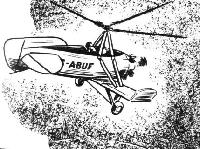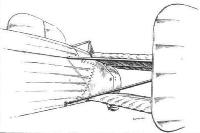
Cierva (автожиры X. Сиервы)
<...>
Наиболее полезным из ранних проектов Сиервы стал автожир С.19, строившийся в ряде вариантов, главным образом фирмой "Avro". Первые три из них, обозначенные Avro Type 620, были заложены как С.17 Mk II, но закончены как автожиры С.19 Mk I. Пока Сиерва разрабатывал системы несущих винтов для предыдущих моделей, планеры "Avro" модифицировались из существующих типов самолетов с обычным крылом неизменяемой геометрии. С.19 стал первым серийным автожиром специальной постройки и первым, имевшим систему автораскрутки несущего винта - прежде эту задачу решали с помощью длинного троса и наземной лебедки. Три автожира С.19 Mk I имели звездообразные моторы Genet II мощностью 80 л. с. (60 кВт). За ними последовали три С.19 Mk II, один из них версии С.19 Mk IIA с улучшенной втулкой винта, шесть С.19 Mk III, 15 аппаратов С.19 Mk IVP и один экземпляр экспериментального С.19 Mk V. Все имели моторы Genet Major I мощностью 105 л. с. (78.3 кВт).
Машины С.19 Mk IV, построенные по лицензии немецкой фирмой "Focke-Wulf", имели звездообразные моторы Siemens Sh.14B мощностью 150 л. с. (112 кВт) и получили обозначение С.20. Название С.21 дали проектируемому французскому аппарату С.19 Mk IV, который должна была строить фирма "Liore-et-Olivier". Коды С.22 и С.23, как считается, остались только проектами.
<...>
Описание:
- Cierva (автожиры X. Сиервы)
- Flight, June 1929
BRITISH AIRCRAFT AT OLYMPIA - Flight, January 1930
THE AUTOGIRO - Flight, April 1930
AIRCRAFT FOR THE PRIVATE OWNER - Flight, November 1932
British Aircraft
Фотографии
-
Air Enthusiast 2003-07 / N.Price - Honouring a pioneer
Регистрационный номер: EC-AIM The only C.19 Mk.IVP left in the world, Avro-built EC-AIM at Cuatro Vientos.
-
Flight 1929-07 / Flight
The Cierva "Autogiro": Fitted with an Armstrong-Siddeley "Genet" engine in an American type of cowling, this rotating wing machine is a two-seater light 'plane.
-
Flight 1930-07 / Flight
Captain Rawson "crazy-flying" on the Cierva "Autogiro."
-
Flight 1930-01 / Flight
Flt.-Lt. Rawson demonstrating the Auto-Gyro at Hanworth before the Japanese visitors.
-
Flight 1929-08 / Flight Advertisements
The C 19 Machine with device for starting the rotor blades.
-
Flight 1930-01 / Flight
TESTING THE "AUTOGIRO": On the left Sir Sefton Brancker, Director of Civil Aviation, and on the right Mr. Nigel Norman, one of the owners of Heston Air Park.
-
Aeroplane Monthly 1974-09 / ??? - Hendon Pageantry 1920-37
"OLD FRIENDS": The "Gugnunc" and "Autogiro" aviating above the Gloster Troop Carrier.
The Handley Page “Gugnunc” climbs away steeply over the Gloster G.33 Goshawk troop transport/bomber, J9832, during the 1932 pageant.Другие самолёты на фотографии: Gloster TC.33 Goshawk - Великобритания - 1932Handley Page Gugnunc / H.P.39 - Великобритания - 1929
-
Aeroplane Monthly 1983-07 / P.Capon - Capon's Corner
Регистрационный номер: G-AAGK The Prince of Wales inspects Cierva C.19 Mk I, G-AAGK, at Hamble on September 3, 1929. Test pilot Rawson is sitting in the cockpit. This aircraft was sold abroad in January 1930.
-
Flight 1930-01 / Flight
Регистрационный номер: G-AALA [5] THE CIERVA "AUTOGIRO": The machine Is seen during its take-off run. Note that the rotor blades have not yet risen to their normal flying position.
-
Flight 1930-04 / Flight
Регистрационный номер: G-AALA [5] THE AUTOGIRO: The Auto giro is now to be seen at nearly all the flying meetings, and never fails to create great interest.
-
Flight 1930-01 / Flight
Регистрационный номер: G-AALA [5] Sir Sefton Brancker piloted an Autogiro C.19, Mark II, on January 7th at Heston and made one take-off and one landing. He said that it was very easy to fly and gave him a great feeling of confidence.
-
Flight 1930-01 / Flight
Регистрационный номер: G-AALA [5] THE SELF-STARTER: In this view the elevator is at its maximum position for deflecting the slipstream on to the rotor blades.
-
Flight 1930-01 / Flight
IN FULL FLIGHT: Although not revolving at more than about 160 r.p.m., the rotor blades of this "Autogiro" defeated our photographer.
-
Aeroplane Monthly 1983-07 / P.Capon - Capon's Corner
Регистрационный номер: G-AAUA [6] C.19, Mk IIA, G-AAUA seen outside of the Avro Hamble experimental works in April 1930. This aircraft was used by Don J. de la Cierva for his flight from England to Spain and back in August/September 1930.
-
Flight 1930-05 / Flight
Регистрационный номер: G-AAUA [6] THE LATEST "AUTOGIRO": Fitted with an Armstrong-Siddeley "Genet Major" engine, this machine is characterised by a rotor of somewhat different design, with larger blades and lower speed. The performance has improved in various respects, and altogether this latest type is said to mark yet another step forward in the evolution of a very interesting aircraft type.
-
Air Enthusiast 2003-07 / T.Hiett - Cierva's rotating wings
Регистрационный номер: G-AAUA [6] C.19 Mk.II G-AAUA in flight in 1930.
-
Aeroplane Monthly 1983-07 / P.Capon - Capon's Corner
Регистрационный номер: G-AAUA [6] -
Flight 1930-06 / Flight
Регистрационный номер: G-AAUA [6] THE CIERVA "AUTOGIRO": Instead of wings, this machine has a "windmill," which is caused to rotate by the passage of the machine through the air. The machine cannot stall. The engine is a "Genet."
-
Flight 1930-07 / Flight
Регистрационный номер: G-AAUA [6] The "Freak Formation": The Cierva Autogiro in the lead, with the Handley Page Gugnunc on the left and the Hill Pterodactyl on the right.
Другие самолёты на фотографии: Handley Page Gugnunc / H.P.39 - Великобритания - 1929Westland-Hill Pterodactyl - Великобритания - 1925
-
Flight 1931-07 / Flight
EXPERIMENTAL RESEARCH: THE HANDLEY PAGE "GUGNUNC," THE CIERVA "AUTOGIRO," AND THE HLLL-WESTLAND "PTERODACTYL" IN FLIGHT FORMATION. RIGHT-HAND CIRCUITS WERE MADE SO THAT THE GUGNUNC COULD "MARK TIME" WHILE THE "PTERODACTYL" WENT FULL SPEED.
Другие самолёты на фотографии: Handley Page Gugnunc / H.P.39 - Великобритания - 1929Westland-Hill Pterodactyl IV - Великобритания - 1931
-
Flight 1930-10 / Flight
The Handley Page "Gugnunc," the "Autogiro," and the Westland-Hill Pterodactyl formating at Croydon.
Другие самолёты на фотографии: Handley Page Gugnunc / H.P.39 - Великобритания - 1929Westland-Hill Pterodactyl - Великобритания - 1925
-
Aeroplane Monthly 1983-07 / P.Capon - Capon's Corner
Регистрационный номер: G-AALA [5], G-ABFZ [3] Assembled for a demonstration of C.19s at Hamble on February 19, 1931, can be seen, from left to right, G-AAY(N or P), G-AAK(Y or Z), G-ABFZ, an unidentified Mk III and G-AALA.
-
Aeroplane Monthly 1983-07 / P.Capon - Capon's Corner
Регистрационный номер: G-AAYP [7] Cierva C.19, Mk III, G-AAYP at Hamble in 1930. It was scrapped in 1938.
-
Flight 1931-06 / Flight
Регистрационный номер: G-AAYP [7] CONVINCING: This photograph shows better than any we have seen the ability of the Cierva "Autogiro" to land in a confined space. The pilot was Mr. Brie.
-
Flight 1931-07 / Flight
Регистрационный номер: G-AAYP [7] A fine photograph of the Autogiro just after Mr. Alliot had removed the tape from its tail skid while it was flying across the aerodrome. The tennis court used for landing can be seen in the foreground.
-
Flight 1931-03 / Flight
Регистрационный номер: G-AAYP [7] The Autogiro C. 19. Mk. III (Genet Major) flown by Mr. Brie at Heston.
-
Aeroplane Monthly 1986-09 / F.Bullmore - Circus Pilot (5)
Регистрационный номер: G-AAYP [7] A Cierva C.19, similar to that flown by the author.
-
Flight 1931-03 / Flight
Регистрационный номер: G-AAYP [7] THE AUTOGIRO AT HANWORTH: Col. Sempill explains the "old Dutch scenery" to Princess Takamatsu.
-
Flight 1930-11 / Flight
Регистрационный номер: G-ABCK Cierva Autogiro C.19 Mark III Light Aeroplane.
-
Aeroplane Monthly 1999-06 / P.Jarrett - Creatures of the air /Strange plumage/
Регистрационный номер: K1948 Reportedly seen at Andover in June 1932, this anonymous Cierva C.19 Autogiro (possibly K1948) has been turned into a fearsome beast by the uninhibited use of a generous range of colours. The C.19 made regular appearances at the interwar RAF Displays, where it usually appeared in a novelty act in company with the Westland Pterodactyl IV and the Handley Page H.P.39 Gugnunc, all three being finished in weird schemes.
-
Air-Britain Archive 1981-03
Регистрационный номер: ZK-ACL The C.19 Autogyro ZK-ACL which was active in New Zealand for less than four months.
-
Air Enthusiast 2003-11 / Round-Out
Регистрационный номер: G-AAHM [3] The unmarked C.19, Mk.IV experimental machine G-AAHM at Hamble in July 1931. In deep conversation behind the Autogiro can be seen test pilot Rawson, left, and the designer, Cierva.
-
Aeroplane Monthly 1983-07 / P.Capon - Capon's Corner
Регистрационный номер: G-AAHM [3] Another view of the experimental C.19 Mk IV, G-AAHM, taken at Hamble on July 24, 1931.
-
Flight 1931-11 / Flight
Регистрационный номер: G-AAHM [3] "FORMATING": The two new Autogiros are here seen taking off at Stag Lane aerodrome, the C.24 piloted by Senor de la Cierva and the C.19 Mark IV by Captain Rawson.
Juan de la Cierva flying the C.24 in company with the prototype C.19 Mk IV G-AAHM at Stag Lane on November 12, 1931.Другие самолёты на фотографии: Cierva/De Havilland C.24 - Великобритания - 1931
-
Jane's All the World Aircraft 1980 / Encyclopedia of Aviation - Aircraft A-Z - v2
Регистрационный номер: G-AAYP [7] Cierva C.19 Mk IV.
-
Aeroplane Monthly 1986-09 / F.Bullmore - Circus Pilot (5)
Регистрационный номер: G-ABFZ [3] BY AUTOGIRO TO THE CAPE: The Cierva Autogiro C.19 Mark IV (100 h.p. Armstrong Siddeley "Genet"), in which Mr. J. N. Young set out from Hanworth on April 25, on a flight to the Cape. He landed at Beauval, near Amiens, for fuel, and proceeded to Abbeville next day
Cierva C.19 Mk IV, G-ABFZ, flown by the author throughout the 1935 season. In December 1935 ’FZ was sold to Capt H. R. S. Howe and remained at Ford until scrapped in 1937. -
Aeroplane Monthly 1986-05 / F.Bullmore - Circus Pilot (1)
Регистрационный номер: G-ABFZ [3] One of two Cierva C.19 Mk IVPs flown by National Aviation Day Displays, often piloted by the author.
-
Aeroplane Monthly 1989-08 / Personal album. Civil
Регистрационный номер: G-ABGB [6] Cierva C.19 Mk IV G-ABGB was built in 1931 and delivered to Alan Cobham's National Aviation Day Displays Ltd in April 1932. In December that year it went to South Africa with the company but crashed at a display in Cape Town on February 17, 1933. The autogiro was probably photographed at Cardiff when NAD visited there on June 1 and 2,1933.
-
Aeroplane Monthly 1986-09 / F.Bullmore - Circus Pilot (5)
Регистрационный номер: G-ABGB [6] Two views of Cobham’s first Cierva C.19, G-ABGB, lost in a National Aviation Day Display show at Cape Town on February 17, 1933.
-
Aeroplane Monthly 1976-12 / B.Williams - On tour with Cobham's Circus
Регистрационный номер: G-ABGB [6] Cierva C.19 Mk IV G-ABGB flew with National Aviation Day Displays until February 13, 1933, when it crashed during a display at Cape Town. Cobham purchased C.19 G-ABFZ as a replacement and this Autogiro was flown during the 1935 tour.
-
Flight 1932-12 / Flight
Регистрационный номер: G-ABGB [6] The Avro 621 "Tutor" and the Autogiro of Sir Alan's Circus flying in typical Cape Town scenery.
Другие самолёты на фотографии: Avro Tutor/Sea Tutor/Prefect / Type 621/646/626 - Великобритания - 1929
-
Aeroplane Monthly 1986-03 / H.Morris - The Barnstormer's Apprentice (5)
Регистрационный номер: G-ABGB [6] The National Aviation Day display invariably opened with a Grand Flypast. This one consisted of, from top to bottom: de Havilland D.H.82 Tiger Moth G-ABUL; D.H.83 Fox Moth Youth of Newfoundland; Airspeed Ferry G-ABSI; Handley Page Clive G-ABYX Youth of Australia; Cierva C.19 Autogiro G-ABGB; Airspeed Ferry G-ABSJ; Fox Moth G-ACEX Youth of Ireland and Tiger Moth G-ACEZ.
Другие самолёты на фотографии: Airspeed Ferry / AS.4 - Великобритания - 1932De Havilland Fox Moth / D.H.83 - Великобритания - 1932De Havilland Tiger Moth / D.H.82 - Великобритания - 1931Handley Page Hyderabad/H.P.24 / Hinaidi/H.P.33 / Clive/H.P.35 - Великобритания - 1923
-
Aeroplane Monthly 1983-07 / P.Capon - Capon's Corner
Регистрационный номер: G-ABUD [2] Cierva C.19, Mk IVP, photographed at Colchester, probably in the winter of 1932/3.
-
Aeroplane Monthly 1990-10 / B.Elliott - The flying squad (1)
Регистрационный номер: G-ABUD [2] Flt Lt Allen over Teddington and Kingston on his way to observe the traffic over Epsom on June 1, 1932 in Cierva C.19 Mk IV G-ABUD, owned by the Autogiro Flying School at Hanworth.
-
Aeroplane Monthly 1990-10 / B.Elliott - The flying squad (1)
Регистрационный номер: G-ABUF [3] Cierva C.19 Mk IVP G-ABUF was used to oversee Derby Day traffic on May 31, 1933. This photograph was taken at Brooklands on July 24, 1932 during a take-off and landing competition during which contestants were required to take off with the shortest possible run, climb to 1,000ft in the shortest time, stop the engine and glide down to a mark on the ground, taking as long as possible over the glide, touching the aerodrome as near this mark as possible and landing with the shortest run possible. R. A. C. Brie, the pilot of the C.19, came second.
-
Flight 1932-07 / Flight
Регистрационный номер: G-ABUF [3] "UP AND AWAY": Mr. Brie lifting the "Autogiro" from the ground for a steep climb when competing at Brooklands on Sunday.
-
Air Enthusiast 2003-07 / T.Hiett - Cierva's rotating wings
Регистрационный номер: G-ABUG Sold in Sweden in 1935, C.19 Mk.IV G-ABUG.
-
Flight 1934-05 / Flight
AN AUTOGIRO FOR INDIA: Raj Kumar Shri Ghanshyamsinhji of Limdi, who is at present taking his British "A" pilot's licence on the Autogiro at Hanworth. He has placed an order for a C.30-type Autogiro, which he intends taking back with him to India, where he already holds the Indian "A" licence.
-
Flight 1932-07 / Flight
THE FIRST FOCKE-WULF "AUTOGIRO." Of the C.19, Mark IV, type, this machine is fitted with a Siemens-Halske 7-cylinder radial engine of 110 h.p. The first test flights were carried out by Capt. A. H. C. Rawson, and will now be continued by the Focke-Wulf and D.V.L. pilots.
-
Flight 1932-05 / Flight
The start of the first heat for the Race at Skegness: (Left to right) "Avian," "Cadet," "Avian," "Spartan," "Widgeon" and Autogiro - the last, in its first race.
Другие самолёты на фотографии: Avro Avian / Type 594/616 - Великобритания - 1926Avro Cadet / Type 631/643 - Великобритания - 1932Simmonds Spartan - Великобритания - 1928Westland Widgeon - Великобритания - 1924
-
Aeroplane Monthly 1990-10 / B.Elliott - The flying squad (1)
Derby Day 1932. Sidney Chamberlain in the front cockpit and Ralph Allen in the rear of a Cierva C.19.
-
Flight 1932-07 / Flight
THE FIRST FOCKE-WULF "AUTOGIRO." The engine-driven rotor starter, pyramid and rotor head.
-
Flight 1932-11 / Flight
Регистрационный номер: G-ABXP LANDING EXTRAORDINARY: The latest type of experimental Autogiro has no fixed wing, no ailerons, and no elevator. Control is by tilting the rotor direct. The machine can be landed with its tail wheel touching first, the rest of the aircraft then sinking quite slowly to earth. When this picture was taken Mr. de la Cierva was landing the machine in this fashion.
-
Flight 1930-06 / Flight
CENTRE OF ATTRACTION: Visitors at Tollerton were especially interested in the D.H. "Puss Moth," with its inverted "Gipsy" engine, and the Autogiro, which took part in the Pageant.
Другие самолёты на фотографии: De Havilland Puss Moth / D.H.80 - Великобритания - 1929
-
Flight 1930-09 / Flight
BEDFORD: The line up of demonstration machines, showing Metal Moth (Gipsy I), Puss Moth (Gipsy III). Desoutter II (Gipsy III), Moth (Cirrus III), Avian (Hermes), Autogiro (Genet Major).
Другие самолёты на фотографии: Avro Avian / Type 594/616 - Великобритания - 1926De Havilland Gipsy Moth / Moth X - Великобритания - 1928De Havilland Puss Moth / D.H.80 - Великобритания - 1929Koolhoven FK-41 - Нидерланды - 1928
-
Aeroplane Monthly 1976-12 / B.Williams - On tour with Cobham's Circus
Регистрационный номер: G-ABGB [6] Flt Lt Turner Hughes eyes the crowd from Tiger Moth G-ABUL as he flies inverted over Avro 504K G-ABHI and Cierva C.19 G-ABGB.
Другие самолёты на фотографии: Avro Avro 504 - Великобритания - 1913De Havilland Tiger Moth / D.H.82 - Великобритания - 1931
-
Flight 1936-04 / Flight
Регистрационный номер: G-ABUC Unrehearsed item: The elderly C.19 Autogiro which visited the Rally lives up to its registration letters.
-
Air Pictorial 1995-04
Регистрационный номер: SE-ADU The Cierva C.19 Mk IV SE-ADU on the deck of the Lise after it had been recovered from the Baltic, together with its pilot, in September 1940.
-
Flight 1933-11 / Flight Advertisements
Регистрационный номер: G-ABUF [3] -
Flight 1929-07 / Flight
The biplane tail on the Cierva "Autogiro." By tilting the horizontal surfaces upwards they can be made to act as deflectors, and thus assist in starting the rotor.
-
Flight 1929-07 / Flight
Cierva Autogiro C.19 Armstrong Siddeley "Genet" Engine
- Фотографии

